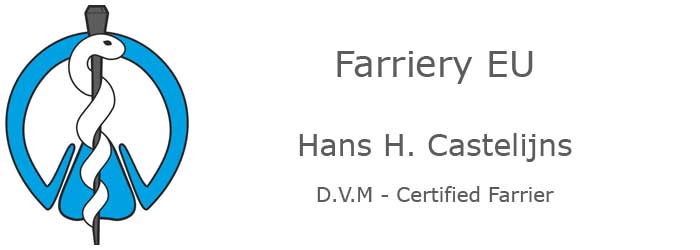 |
Nutrition for healthy hoovesIn order for a horse to enjoy healthy hooves, an adequate food intake, both in quantity and quality is essential. As far as quantity goes it should be pointed out that excessive food intake especially regarding carbohydrates, can have dramatic consequences on the horse's hooves; not only is there a mechanical overloading in the case of obese horses, but some (especially cold bloods and ponies) easily develop fatty liver syndrome (lipidosis) and laminitis. As far as quality goes, the diet should contain all necessary ingredients for keratin synthesis, which is a structural protein of which hooves are built (as is hair).
All parts of the hoof, that is hoof wall, sole and frog are made up of keratin, which is a structural insoluble protein which is also found in skin, hair, manes and tails. Like all proteins, keratin is made up of long chains of amino acids, the building blocks of all proteins. These amino acids (AA) can be divided in A.A. which the body can synthesize itself, and AA, which are called “essential” and which the horse has to take up through it's dietary intake. The most important essential A.A. for keratin synthesis are the sulphurated AA methionine and cysteine which form up to 14% of the total AA in keratin and which are responsible for the bi-sulphurous bonds (-S-S-) between keratin molecules, confering structural strength to the hoof. Another important essential AA is Lysine. All protein synthesis is enzyme facilitated, which means that adequate protein synthesis, indispensable for healthy hoof growth, also depends on sufficient vitamin and mineral intake necessary for enzyme synthesis and function. The specific microelements identified as necessary for keratin formation include biotin, vitamin A, E, D3, B group vitamins (nicotinic, pantotheic and folic acids) and the minerals iron, manganese, zinc, copper, iodine, cobalt and selenium. Average normal hoof wall growth, which takes place at the coronary band or corium is ( 6-8 mm / month in the adult horse and up to twice as fast in the foal. For this blood supply, which ultimately carries the building blocks of keratin synthesis into the foot, to function properly, the horse needs exercise and hoof elasticity (which is determined by water contents of the hoof). In other words a horse which stands for too many hours in dry bedding will have a worse circulation in the foot (and less hoof growth) than a horse which is out in a grassy paddock for most of the day. As most farriers and equine veterinarians are well aware of, the hoof is a mirror of the horse's general health over the last 6-9 months. Marked growth rings or depressions, parallel to the coronary band, visible on the hoof's surface of all 4 feet may indicate past illnesses, inflammation, dietary changes or deficits. In the case of poor quality hooves or specific pathologies, such as white line disease (onicomicosis), laminitis or hoof avulsions, it is important to accelerate hoof growth as much as possible. A good look at the usual diet of the horse and the use of a hoof growth supplement can be effective way to get the patient “on his feet” earlier. A good supplement should; guarantee the daily uptake of the wide variety of necessary elements for hoof growth; be fresh and appetizing for the horse; stable (pellet forms are more stable than powdered supplements), and usually be given for at least 6 months. The first signs of their effect on the horse are usually seen within weeks as the coat (hair also depends on keratin synthesis) becomes shinier. |
Hans Castelijns
D.V.M - Certified Farrier